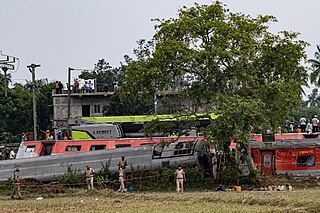
An aviation accident is defined by the Convention on International Civil Aviation Annex 13 as an occurrence associated with the operation of an aircraft, which takes place from the time any person boards the aircraft with the intention of flight until all such persons have disembarked, and in which (a) a person is fatally or seriously injured, (b) the aircraft sustains significant damage or structural failure, or (c) the aircraft goes missing or becomes completely inaccessible. Annex 13 defines an aviation incident as an occurrence, other than an accident, associated with the operation of an aircraft that affects or could affect the safety of operation.

The Quintinshill rail disaster was a multi-train rail crash which occurred on 22 May 1915 outside the Quintinshill signal box near Gretna Green in Dumfriesshire, Scotland. It resulted in the deaths of over 200 people and remains the worst rail disaster in British history.
The Gaisal train collision occurred on 2 August 1999, when two trains carrying about 2,500 people collided at the remote station of Gaisal in West Bengal, India. Owing to a signalling error, both trains were using the same track on a day when three of the four tracks on the line were closed for maintenance. Their combined speeds were so great that the trains exploded on impact, killing at least 285 people.
The Karanjadi train crash was an accident resulting in derailment of a passenger train at Karanjadi, a village in Maharashtra, India, on 17 June 2004. 20 people were killed and well over 100 injured in the crash, which was the result of heavy monsoon rains.
The Khanna rail disaster occurred on 26 November 1998 near Khanna on the Khanna-Ludhiana section of India's Northern Railway in Punjab, at 03:15 when the Calcutta-bound Jammu Tawi-Sealdah Express collided with six derailed coaches of the Amritsar-bound "Frontier Mail" which were lying in its path. At least 212 people were killed; the trains were estimated to be carrying 2,500 passengers. The initial derailment was caused by a broken rail. The crash is among the deadliest rail accidents in India.
On 13 January 1985, an express train derailed on a curved bridge over the gorge of the Awash River in Awash, Ethiopia. The official death toll was 428, with more than 500 injuries.
The Yanga derailment occurred on 21 June 2010 when a train traveling between Brazzaville and Pointe Noire in the Republic of the Congo was derailed and plunged into a ravine. At least 60 people were initially reported to have been killed and hundreds disappeared with the death toll expected to rise further. The death toll had risen to 76 people and the injury toll had risen to 745 by 23 June 2010.
The Bouhalouane train crash was a fatal railway accident that happened at Bouhalouane in Algeria on January 27, 1982 at 01:30 and killed 131 people.

On 20 November 2016, the Indore–Patna Express 19321, a scheduled train from Indore to Patna, derailed near Pukhrayan, Kanpur, India, resulting in the death of 150 passengers and injuries to at least another 150.

On June 2, 2023, three trains collided in Balasore district in Odisha state of eastern India. The Coromandel Express entered the passing loop instead of the main line near Bahanaga Bazar railway station at full speed and collided with a goods train. Due to the high speed of the Coromandel Express, its 21 coaches derailed and three of those collided with the oncoming SMVT Bengaluru–Howrah Superfast Express on the adjacent track.
The 1956 Ariyalur train accident was a train accident on 23 November 1956 in Ariyalur, Tamil Nadu, India, where a train fell into the Marudaiyaru River, killing over 150 passengers after a bridge collapsed as a result of damage by torrential rain.




